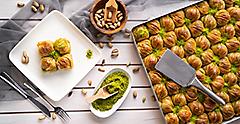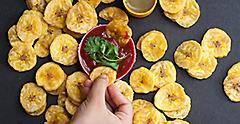Just Add Milk, Eggs, And Flour For Best Travel Vacations
It seems almost impossible that three simple ingredients — milk, eggs and flour — could be the base for one of the best desserts in the world. But it's this humble trio that forms the foundation of the world-famous Samobor kremšnita (or custard slice in English). Sure, you can go to Lake Bled in neighboring Slovenia to grab a slice or visit nearby Zagreb, but none of them compare with those found in Samobor.
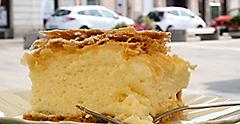
This medieval town, replete with Baroque architecture evoking a French feel, is a must-visit — not only for its architecture and picturesque location in the Sava River Valley but also for this superlative custard slice. It's said that this creation belongs to Samobor native Đuro Lukačić. In the 1920s, Đuro studied pastry in Zagreb, Vienna and Budapest and combined some of the recipes he learned there to create this stellar dessert. While there may be an Austro-Hungarian influence to this custard slice, it's Đuro who is the father of the Samobor kremšnita (although some also credit Slovenian Istvan Kovačevič for creating his version of it in the 1950s).
The Samobor town square is home to various bakeries, pastry shops and cafés, all vying for kremšnita supremacy. But locals claim that Slastičarnica U Prolazu is the place to go. I made a stop there along with my mother-in-law, daughter and husband. We descended on the little pastry shop like a pack of hungry wolves, enticed by the sweet smell of vanilla and baked goodness that wafted from the front door. The vanilla custard souffle with whipped cream sandwiched between perfectly crisp sheets of thin mille-feuille-like pastry tamed us. There we sat out on the terrace, enjoying the decadent pairing with a piping hot coffee.
I've had kremšnita that's dense like a firmly set custard, and I've had some that's a little more pudding-like, but never had I tried one like this: a light-as-air version that disappears in your mouth. It was a textural symphony, and my family and I just about stood up en masse for an ovation. Taste for yourself why this is one of Croatia's most beloved desserts.
All About The Almond Desserts
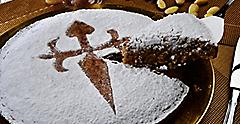

Years ago, when I was in Santiago de Compostela in late fall, I noticed the cake in just about every bakery and café window that I walked by en route to the Cathedral of Santiago de Compostela, where the aforementioned saint's relics are said to be buried. It's here where pilgrims who made their way across hundreds of miles of terrain on the Camino de Santiago (St. James Way) end up paying their respects and beginning a day of feasting. The tarta is part of that celebration.
The origins of the cake are somewhat blurry, but there is written reference dating as far back as 1577, with the first recipe appearing in 1838. There are versions containing cinnamon, but I concur with food historian, cookbook author and writer Claudia Rodin — who is as much a fan of this dessert as I am — that the cakes flavored with orange and a little lemon zest are the best. My advice: Go to a bustling café full of locals (not tourists), order a slice, and enjoy listening to Spanish and Galician being spoken amidst the aroma of freshly roasted coffee and smatterings of laughter and lively conversation.
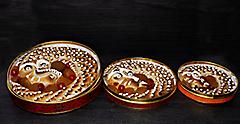
Much further south, in the beautiful hilltop town of Toledo, the almond also reigns supreme. But this time, it's in the form of marzipan at Santo Tomé. Levantine almonds, sugar, alcarria honey and local eggs are the only ingredients used in the beautiful creations handcrafted by the artisans at this family-owned and operated confectionary shop. To be considered a mazapán de Toledo (marzipan from Toledo), at least 50% of the final product needs to be comprised of almonds.
The marzipan tradition dates back to the medieval ages, brought to Spain by Arabs who knew the intricacies of this fine almond paste. At Santo Tomé, the family has been using these artisanal techniques since 1856 in the city's historic center. You can visit the factory's kitchen area for an intimate look into the creation of this sweet treat as artisans deftly sculpt eels, flowers, fruits and fanciful shapes out of the ready-to-use marzipan paste. It smells of floral honey, almond essence and sugar — what every sweet dream is made of.
Don't miss the shop at the factory, where you can purchase a selection of treats to take home, and if you're like me, you'll be excited to sample a little marzipan first. There's so many to choose from, such as fruit shapes with a chocolate core filled with jam, others baked into cookies studded with roasted pine nuts and little fish stuffed with "angel hair" (made of sweet pumpkin pulp). Fragrant, flavorful and lightly floral, it's the furthest thing from commercial marzipan you'll ever try. Almond-lovers will savor it, and home-bakers will appreciate the fine craftsmanship. You have to see and taste these to believe it. Fortunately, for marzipan aficionados, the popularity of Santo Tomé is such that they ship their beautiful product worldwide.
French Savoir-Faire

If you visit Paris, do yourself a favor and stop by one of Pierre Hermé's stunning pastry boutiques and treat yourself to some of the finest pastries and chocolates that will likely ever grace your tongue. Hermé, a Knight of the Legion of Honor in France (along with too many other accolades to count), is often referred to as the "Picasso of Pastry." He doesn't just make a dessert — he designs them, often starting with sketches like an architect. This couture approach is apparent in his boutique, too. It feels like you're in a fine jewelry store where every morsel is displayed like a bespoke gem under perfect lighting, in impeccably flawless condition.
Hermé's strengths are in updating classic, French pastries. If you're a fan of the much-lauded macaron, for example, you'd be hard-pressed to try one better than his. Larousse Gastronomique, the culinary encyclopedia, states that the origins of this merengue, sugar and almond flour confection date back to 791 A.D., where they were made in a French monastery in Cormery, France. However, lore has it that it was introduced in France by the Italian chef of Queen Catherine de Medici during the Renaissance period.
Either way, by the 19th century, a Parisian-style macaron filled with ganache, jam or buttercream and sandwiched between two almond merengue biscuits became the fashionable way to consume these treats. Melt-in-your-mouth macarons took the pastry world by storm and continue to be fan favorites. For a taste of spring freshness, try Hermé's Ispahan made with rose, litchi and raspberry, or try an orange blossom macaron for a Mediterranean nuance. If macarons aren't your thing, worry not; there's a whole boutique-full of edible jewels for you to enjoy.
The Chemist's Take On The Egg Tart
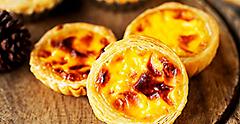
In the Portuguese colonial town of Coloane Village, British-born pharmacist-turned-baker Andrew Stow started experimenting with a recipe that would become one of Macau's most iconic desserts. When I visited the simple shop, tucked away in a narrow street, I met Andrew's sister, Eileen Stow, who explained that the late Andrew and his wife, Margaret, opened the Coloane outpost in 1989 and started gaining notoriety when journalists "discovered" his creation. His particular tart combines a Portuguese pasteis de nata with a Chinese egg tart — which, ironically, is inspired by the English custard tart.
Stick with me here, because the British gent decided that a melding of these treats would make the quintessential tart, made with a just-set, vanilla-scented egg custard and a crackled top, like a crème brulée. Andrew was inspired by his visit to Belém in Portugal, where he enjoyed pasteis with a shot of espresso. His sister smiled as she recalled him thinking, "Why don't we have this in Macau?"
After years of experimentation, the Portuguese egg tart (as locals dubbed his creation) was born. Tourists soon started arriving for a just-pulled-from-the-oven tart, a coffee and a sweet memory of Macau.
Eileen invited me inside the original bakery's compact kitchen, where I watched in awe as artisans speedily molded pastry shells in tins while another team of women efficiently followed, filling each cup just beyond the brim before putting each tray into a hot oven. I sat with Eileen in a nearby courtyard, enjoying a plate of tarts while Andrew's legacy surrounded us with every delicious bite. Each mouthful of silky, smooth custard contrasts with the shatteringly crisp brûléed top, and delicate pastry floods the palate in a sweet veil of vanilla — possibly one of the best treats you'll ever enjoy.
Stow's recipe has had innumerable imitators all over Asia, but for my money, the original found in sleepy Coloane is still one of the best desserts in the world.
Travel For Sweet Tropical Twists On Desserts

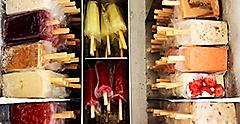
These aren't just run-of-the-mill paletas; they're the most mouth-watering, tropical fruit-filled popsicles you've ever had. You're at the source of locally grown fruit, including mangoes, star fruit, passion fruit, lulo (a unique fruit that tastes like a combo of pineapple, orange and lime), and more. This is the x-factor that gives this iced water or yogurt-based treat-on-a-stick it's allure. One of my favorites, apart from lulo, is the Andean blackberry (or mora). It's intensely sweet, tart and tangy, stirring memories of my childhood when I'd enjoy this fruit in smoothies or milkshakes. And, given how hot this tropical city is, there's nothing more perfect than buying a paleta, walking around the old town while the sun shines bright, and licking this tropical treat with abandon. It's the stuff that food memories are made of.
When I think of the cold, crystal-like icy granita I enjoyed on a terrazza in Sicily, or the chewy, almost gum-like texture of a mochi filled with black sesame seeds in Japan, I can almost taste it on my tongue and feel myself being transported. But I've only scratched the surface of the best desserts around the world. Travel the world, one sugar rush at a time, and you'll find there are only more to be found. Whether you're looking to try something new or revel in nostalgia on a plate (or on a stick), the world is literally your oyster.
Get Royal Deals, Sign Up Today

Getting There
Explore Our Most Affordable Itineraries
Satisfy your sweet tooth on the Ultimate World Cruise.




